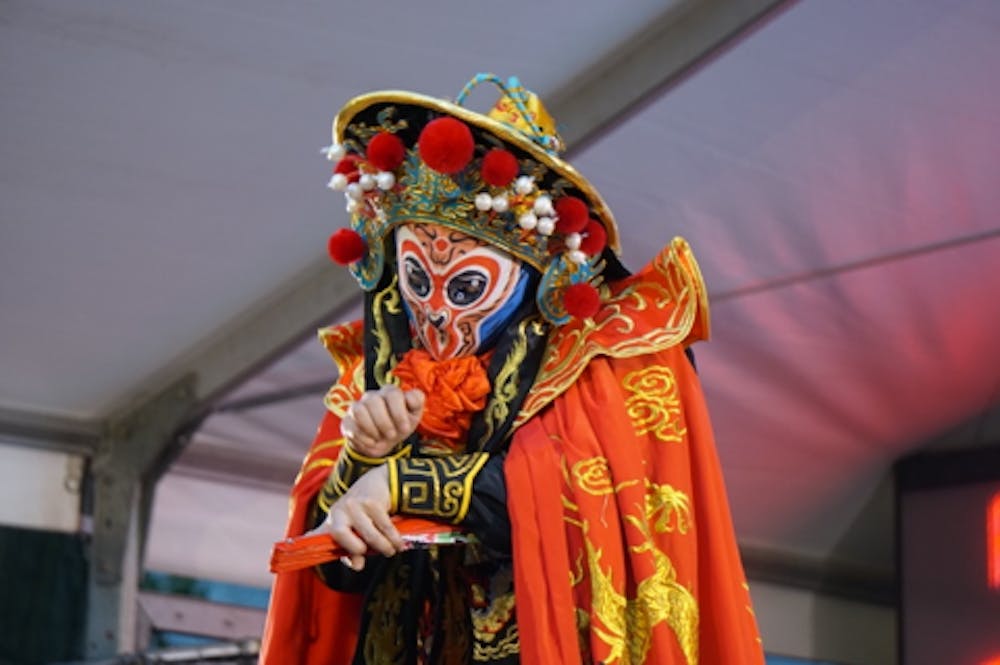The air in Philly was humid, but the clouds were rain–less. I joined crowds of families and curious citizens alike gathered in Franklin Square all day on Saturday, June 15th, for the Philadelphia Chinese Lantern Festival. The event runs from May 1st to June 30th.
Walking to the event along Race Street, it was hard to ignore the vibrant red hues and welcoming sound of the erhu (a Chinese musical instrument) coming from the outside. I made sure to use my $18 weekend student discount, and ventured inside.

From the onset, I was overwhelmed with the amount of color. Styled in the form of fish, dragons, phoenixes, and other natural elements—there were twenty-nine red, green, blue, yellow, and multi-colored lantern sculptures decorating Franklin Square. The centerpiece was an ornately decorated dragon, looming over us at a great height. The dragon is often the centerpiece of New Year celebrations as for some, it symbolizes the origin of the Chinese people.
Traditionally in China, the Lantern Festival is celebrated on the 15th day of the first month in the Chinese calendar. The festival originated over 1000 years ago in the Han dynasty. A vivid motif of these annual celebrations are the lantern sculptures. Exhibitions are attended by entire families together. I was told that a recent addition to the Philadelphia Lantern Festival is the panda exhibition. The popular exhibits feature Four Chinese Mythical Creatures, Dragon lanterns, and Chinese traditional art forms.
There were also three 30 minute performances at 7:30pm, 9:00pm, and 10:30pm as a part of admission to the event. First, we watched a Chinese folk dance featuring a girl in a flowing white traditional dress with peacock fellow decorations ornately adorning her skirt. The crowd gasped and murmured as she effortlessly leaped and danced across the stage to a slow instrumental interlude. I was impressed by her flexibility and grace.

Next was a man and a woman performing a Tai Chi–inspired dance to the rhythmic beat of a drum. Their movements were quick and precise—yet fluid—and their performance offered incredible insight into Chinese martial arts as well as the importance of wellness.

Then, we saw a contortion artist. She dazzled the audience with her incredible flexibility—her feet dancing to soft angelic singing whilst maintaining a hand stand. She was also able to do splits in a bridge position! As the music transitioned to an erhu and flute recorder duet, an assistant ran onto the stage carrying a candelabra with seven flaming arms. She then proceeded to perform the same moves again, this time balancing the flames on her foot effortlessly. To the crowd’s surprise, the assistant returned with 4 more candelabras, with the artist eventually holding two with her arms, two with her feet, and one on a pedestal in her mouth. Needless to say, she received a standing ovation.

After a short intermission, a foot juggler came onstage. At this point, the seating area was packed. As “Glory” by The Twelve Girls Band played, the performer danced while balancing furniture items that ranged from carriage wheels and jars, to tables—and even a chair. She incorporated several Icarian games into her act as well.

Next was a crowd favorite—the “Mysterious Face-Changer”—an incarnation of the ancient Chinese art. This performance style originates with the Sichuan Opera (a type of Chinese opera originating in the Sichuan province around 1700), where silk masks were used to depict changes in mood onstage. The face changer wowed the crowd with his fancy ornaments and swift hand motions. With each flash of the hand, a new mask appeared over his face. He wore over ten layers of brightly colored masks until he eventually revealed his face at the conclusion of his performance. Those around me audibly turned to each other asking, “How does he do it?” and “Is it magic?” He conveyed a mastery of performance dexterity and showmanship as he danced to the tune of “Mask Change” by Chen XiaoTao. According to the performer’s introduction, only 200 people still practice the art of face changing in China today.
It was a pleasure to get the chance to experience this special Chinese celebration here in Philadelphia, not so far away from Penn’s campus. I highly recommend it for anyone looking to experience something new or celebrate Chinese culture on a local scale.







